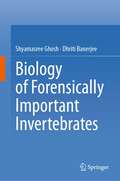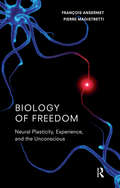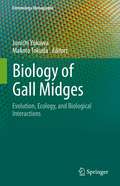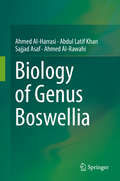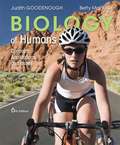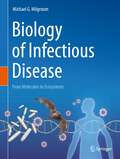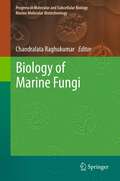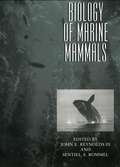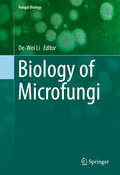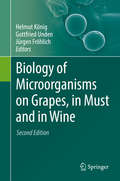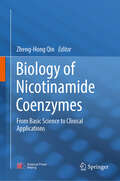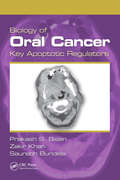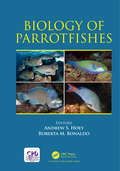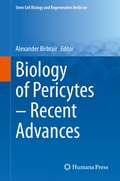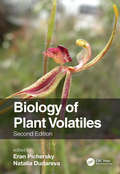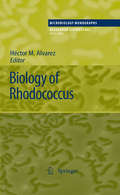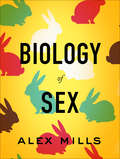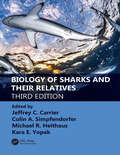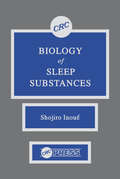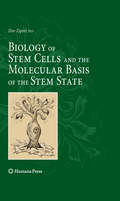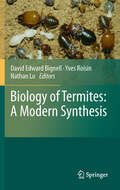- Table View
- List View
Biology of Floral Scent
by Eran Pichersky Natalia DudarevaAs with nearly all living creatures, humans have always been attracted and intrigued by floral scents. Yet, while we have been manufacturing perfumes for at least 5000 years to serve a myriad of religious, sexual, and medicinal purposes, until very recently, the limitation of our olfactory faculty has greatly hindered our capacity to clearly and ob
Biology of Forensically Important Invertebrates
by Shyamasree Ghosh Dhriti BanerjeeThis book emphasizes the important role of invertebrates in forensic sciences in the detection of crimes, determining the time and place of death, estimating the minimum Post-Mortem Interval (PMI), and determining the cause of death. The initial chapter discusses the forensically essential invertebrates, especially flies under Order Diptera. Further, the book highlights the importance, biology, taxonomy, and biodiversity of flies under Order Diptera with forensic importance. It also discusses the Cuticular HydroCarbons (CHC) and spectrometry-based studies reported from flies and larvae of forensic importance. It further reviews the importance of DNA barcoding in molecular taxonomy-based studies on forensic flies through understanding, identification, and grouping the organisms. Towards the end, this book presents the applications and limitations of forensic entomology in cases of animal cruelty to a veterinary professional.
Biology of Freedom: Neural Plasticity, Experience, and the Unconscious
by Francois Ansermet Pierre MagistrettiThis groundbreaking book delivers a much needed bridge between the neurosciences and psychoanalysis. Freud hoped that the neurosciences would offer support for his psychoanalysis theories at some point in the future: both disciplines, after all, agree that experience leaves traces in the mind. But even today, as we enter the twenty-first century, all too many scientists and analysts maintain that each side has wholly different models of the origin and nature of those traces. What constitutes human experience, how does this experience shape us, and how, if at all, do we change our lives? Psychoanalysis and the neurosciences have failed to communicate about these questions, when they have not been frankly antagonistic. But, in Biology of Freedom, Francois Ansermet and Pierre Magistretti are at last breaking new ground. This fully illustrated account, rigorous yet lucid and entirely accessible, shows how the plasticity of the brain's neural network allows for successive inscriptions, transcriptions, and retranscriptions of experience, leading to the constitution of an inner reality, an unconscious psychic life unique to each individual.
Biology of Gall Midges: Evolution, Ecology, and Biological Interactions (Entomology Monographs)
by Junichi Yukawa Makoto TokudaThis book provides practical ecological, ethological, evolutionary, and biogeographic data for gall-inducing cecidomyiids, their galls and host plants, based on field surveys, laboratory experiments and genetic analysis. It refers to various researches on gall-inducing insects published by a world of biologists. Practical methods of field surveys and data analysis are presented, as well as topics on parasitoids, invasive pests, and beneficial gall midges that would be useful for applied entomologists. Readers can learn an ecological way of thinking through diverse interrelations between insects and plants, and the analysis of ecological data from gall-inducing cecidomyiids. Galls can be easily observed in the field continuously from early to final stage of the development of galls and gall inducers because of their outstanding features and immobility. It provides important data of the host plant such as phenology, abundance as food resources, and the survival of galled organs. By taking these advantages, many biologists have used galls and gall-inducing insects as highly convenient organisms for a wide range of studies including ecology, ethology, evolution, and biogeography. The book primarily intends to present the appeal of galls and gall-inducing insects for various biological studies. In particular, gall-inducing cecidomyiids are ideal insects to study ecology and evolution. It helps to open the doors to further cryptic study subjects. Also, integrating various ecological, ethological, evolutionary and biogeographic data as shown in this book can serve to further advance the macroevolutionary studies of insects.
Biology of Genus Boswellia
by Ahmed Al-Harrasi Abdul Latif Khan Sajjad Asaf Ahmed Al-RawahiThis book provides insight into the biology and genomics of the genus Boswellia (family Burseraceae), a natural resource used for the production of frankincense, an oleo-gum resin. The Boswellia species are ecologically, medicinally, commercially and culturally important. Significantly contributing to the paucity of comprehensive literature on this genus, this volume provides a detailed discussion on the genomics, physiology and ecology of Boswellia. The chapters cover a wide range of topics, including taxonomy, distribution, genetic diversity and microbiology. The production process of frankincense and its impact on the species are presented as well. In light of the recent decline of various Boswellia populations, species propagation and conservation are discussed. Plant scholars, ecologists and conservation biologists will find this book to be an important and informative reference.
Biology of Humans: Concepts, Applications, and Issues (6th Edition)
by Judith Goodenough Betty A. McGuireFor courses in non-majors biology. Helps students learn the concepts and applications of human biology using relevant topics and realistic scenarios Known for its unique "Special Topic" chapters and emphasis on everyday health concerns, the 6th Edition of Biology of Humans: Concepts, Applications, and Issues continues to personalize the study of human biology using a conversational writing style, vibrant, easy-to-follow illustrations, abundant applications, and a new emphasis on using everyday science literacy skills. The authors provide a practical, friendly introduction to the study of the human body, preparing readers to navigate today's rapidly expanding and shifting world of health information. Each chapter now features brand-new "Consider This Case" exercises and "Finding and Evaluating Information" activities that challenge readers to think critically and apply their knowledge to solve real-world cases. Along with scientific updates and content improvements throughout the text, the 6th Edition also includes a new "Special Topic" chapter on the Obesity Epidemic.
Biology of Humans: Concepts, Applications and Issues, 5th Edition
by Betty Mcguire Judith GoodenoughEach chapter now opens with new “Did You Know?” questions that pique your interest with intriguing and little-known facts about the topic that follows. The Fifth Edition also features a new “Special Topic” chapter (1a) titled “Becoming a Patient: A Major Decision,” which discusses how to select a doctor and/or a hospital, how to research health conditions, and more.
Biology of Infectious Disease: From Molecules to Ecosystems
by Michael G. MilgroomThis textbook provides a broad introduction to the biological processes underlying infectious diseases in a range of hosts and pathogens. The text covers topics at all levels of biological organization, from the molecular and cellular level, organismal level, and population and ecosystem level, and goes well beyond infectious diseases of humans. The details of how microbes interact with their hosts are unique for each interaction, but emphasis is on the common principles of host-pathogen interactions that result in disease. Biology of Infectious Disease: From Molecules to Ecosystems is aimed at undergraduate and early graduate-level students in biology or public health, including pre-medical and pre-public-health students, who are interested in a broad introduction to infectious disease but do not have any previous background in microbiology or immunology.
Biology of Marine Birds (CRC Marine Biology Series)
by Joanna Burger E. A. SchreiberBiology of Marine Birds provides the only complete summary of information about marine birds ever published. It analyzes their breeding biology, ecology, taxonomy, evolution, fossil history, physiology, energetics, and conservation. The book covers four orders of marine birds in detail and includes two summary chapters that address the biology of shorebirds and wading birds and their lives in the marine environment. Summary tables give detailed information on various aspects of their life histories, breeding biology, physiology and energetics, and demography. It provides a guide to ornithologists and students for research projects.
Biology of Marine Fungi (Progress in Molecular and Subcellular Biology #53)
by Chandralata RaghukumarThe diversity, ecological role and biotechnological applications of marine fungi have been addressed in numerous scientific publications in the last few years. This enormous spurt of information has led to a dire need among students and professionals alike for a source, which contains comprehensive reviews of various aspects of marine fungi. This book addresses this need, especially since it is written by reputed marine mycologists. The latest information on topics including molecular taxonomy and phylogeny, ecology of fungi in different marine habitats such as deep sea, corals, dead- sea, fungi in extreme marine environments and their biotechnological applications is reviewed. The book presents a comprehensive source of information and analysis aimed at marine fungi for researchers, teachers and students of marine mycology.
Biology of Marine Mammals
by John E. ReynoldsTaking an integrated approach to the biology of marine carnivores, cetaceans, and sirenians, twenty-two prominent researchers compare marine mammals with one another and with terrestrial mammals, providing a framework for fundamental biological and ecological concepts. They describe functional morphology, sensory systems, energetics, reproduction, communication and cognition, behavior, distribution, population biology, and feeding ecology. They also detail the physiological adaptations--for such activities and processes as diving, thermo-regulation, osmoregulation, and orientation--that enable marine mammals to exploit their aquatic environment.
Biology of Microfungi (Fungal Biology #0)
by De-Wei LiThis reference book includes 24 chapters written by a group of experts in the different fields of microfungi and cover a broad range of topics on microfungi. It provides the most updated information on the latest development in systematics and taxonomy of microfungi, new techniques which were developed in the last ten years and their application in microfungal research. After the International Code of Nomenclature for algae, fungi, and plants (Melbourne Code) was adopted by the Eighteenth International Botanical Congress Melbourne, Australia, July 2011, it has had a profound impact on mycology and its research. Fungal nomenclature changes and its significance to fungal taxonomy and naming of microfungi in the future is discussed in detail. Since dual names system for fungi developing both sexual and asexual states, and fungi developing only asexual state is no longer available, the first five chapters will clarify some confusion and provides perspective views on the direction for future research. The next nine chapters cover microfungi and their ecological roles or functions in the different habitats (air, indoor, aquatic, marine, plants, soils, etc). The remaining 13 chapters cover the relationship of microfungi and humans (good and bad) and usage or application microfungi in different industries, such as food, agriculture, forestry, green technology, pharmaceutics, and medicine, as well as in our daily life. The book bridges the gap between basic mycological research and applied mycology and provide readers a unique set of information and knowledge of microfungi generated from multiple angles in different fields of mycology.
Biology of Microorganisms on Grapes, in Must and in Wine
by Helmut König Gottfried Unden Jürgen FröhlichThe ancient beverage wine is the result of the fermentation of grape must. This n- urally and fairly stable product has been and is being used by many human societies as a common or enjoyable beverage, as an important means to improve the quality of drinking water in historical times, as therapeutical agent, and as a religious symbol. During the last centuries, wine has become an object of scientific interest. In this respect different periods may be observed. At first, simple observations were recorded, and subsequently, the chemical basis and the involvement of microorg- isms were elucidated. At a later stage, the scientific work led to the analysis of the many minor and trace compounds in wine, the detection and understanding of the biochemical reactions and processes, the diversity of microorganisms involved, and the range of their various activities. In recent years, the focus shifted to the genetic basis of the microorganisms and the molecular aspects of the cells, including metabolism, membrane transport, and regulation. These different stages of wine research were determined by the scientific methods that were known and available at the respective time. The recent "molecular" approach is based on the analysis of the genetic code and has led to significant results that were not even imaginable a few decades ago. This new wealth of information is being presented in the Biology of Microorganisms on Grapes, in Must, and in Wine.
Biology of Nicotinamide Coenzymes: From Basic Science to Clinical Applications
by Zheng-Hong QinThe book is divided into four parts: the first part introduces the basic concepts of nicotinamide coenzymes, the synthesis of nicotinamide coenzymes, intracellular distribution, and an overview of the main functions and detection methods so that readers can quickly understand the general feature and function of nicotinamide coenzymes; the second part describes the involvement of nicotinamide coenzymes in intracellular signal transduction and their roles in cellular physiological and biochemical processes to explain exactly how nicotinamide coenzymes work in the processes and enable readers to deeply understand the principle of nicotinamide coenzymes playing an important function; the third part describes the role of nicotinamide coenzymes in the pathophysiological process of diseases, tries to illustrate the specific mechanisms of their association with the occurrence of the diseases, and points out the potential value in future translational medicine research; the fourth part introduces the production technology of nicotinamide coenzymes, including precursors, the process of industrial production, and the application of nicotinamide coenzymes and precursors in health industry, medicine, and life science research. This book can be used as a reference book or textbook for undergraduate and graduate students of life sciences, basic and clinical medicine, researchers, and clinicians.
Biology of Oral Cancer: Key Apoptotic Regulators
by Prakash S. Bisen Zakir Khan Saurabh BundelaCancer is a class of disease or disorders characterized by uncontrolled division of cells and the ability of these cells to invade other tissues. One new approach in dealing with cancer is through apoptotic regulators, which is the process of controlling cell growth by abnormally prolonging cell survival, facilitating the accumulation of transforming mutations and promoting resistance. Despite a decline in developed countries, cancer has consistently maintained its status as one of the top killers since time immemorial. Exploring cancer management and treatment at the molecular level, Biology of Oral Cancer: Key Apoptotic Regulators presents a key molecular event-apoptosis-in relation to genesis and progression of oral cancer. This book uses oral cancers as the specific means to demonstrate this technique with this particular type of cancer, which is quite prevalent in India and other parts of Asia.
Biology of Parrotfishes
by Andrew S. Hoey Roberta M. BonaldoParrotfish are found on almost every coral reef in the world. This ubiquity and uniqueness of their feeding action make them one of the most important groups of fishes within coral reef ecosystems. But why, exactly, are parrotfish so important to reefs? Can the evolution of a particular jaw morphology and feeding action really have had such a large impact on the health and functioning of the world's coral reefs? This book introduces the reader to this fascinating group of fishes (Labridae, Scarinae), from the morphological innovation of a jaw that has the power to bite through solid calcium carbonate, to the threats currently faced by parrotfish populations around the world. It contains new insights into their diet and food processing ability, and lifehistories, and concludes with an overview of emerging and future research directions.
Biology of Pericytes – Recent Advances (Stem Cell Biology and Regenerative Medicine #68)
by Alexander BirbrairPericytes were originally discovered and named more than hundred years ago as contractile cells around the blood vessel endothelial cells. Due to the lack of exclusive markers, pericytes are now defined by a combination of location, morphology and gene expression. Pericytes are attracting increasing attention as important regulators during development and during normal and disturbed organ function. In recent years, remarkable progress has been made in the identification and characterization of pericytes subpopulations and their amazing functions using state-of-art techniques. These advantages facilitated identification of molecular basis of interaction between these cells with several other more well studied cell types, and revealed key signals derived from pericytes involved in homeostasis, regeneration, and disease regulation. In the last ten years, several unexpected roles of pericytes have been discovered. It has been demonstrated that pericytes from different tissues differ in their properties as well as functions. Even more, pericytes are heterogeneous also within the same organ. This book is will describe the major contributions of pericytes to different organs biology in physiological and pathological conditions.The book will teach the readers about this so special cell type that 10 years ago was almost completely forgotten, and it was associated basically only with vascular stability. Recently, it become a very hot topic to work in. Several articles in Nature, Science and Cell have been and are being currently published about this cell type. These recent works are revealing how important those cells are for before unimaginable biological processes.Thus, this book will update us on what are the most novel functions attributed to these cells. Also, will introduce to the young generation all the history about these cells from when they were discovered in different organs till where we are now in this field. So it will be a great book for both cell biology students as well as researchers that will have an update on these cells biology in different organs.
Biology of Plant Volatiles
by Eran Pichersky Natalia DudarevaPlant volatiles—compounds emitted from plant organs to interact with the surrounding environment—play essential roles in attracting pollinators and defending against herbivores and pathogenes, plant-plant signaling, and abiotic stress responses. Biology of Plant Volatiles, with contributions from leading international groups of distinguished scientists in the field, explores the major aspects of plant scent biology. Responding to new developments in the detection of the complex compound structures of volatiles, this book details the composition and biosynthesis of plant volatiles and their mode of emission. It explains the function and significance of volatiles for plants as well as insects and microbes whose interactions with plants are affected by these compounds. The content also explores the biotechnological and commercial potential for the manipulation of plant volatiles. Features: Combines widely scattered literature in a single volume for the first time, covering all important aspects of plant volatiles, from their chemical structures to their biosynthesis to their roles in the interactions of plants with their biotic and abiotic environment Takes an interdisciplinary approach, providing multilevel analysis from chemistry and genes to enzymology, cell biology, organismal biology and ecology Includes up-to-date methodologies in plant scent biology research, from molecular biology and enzymology to functional genomics This book will be a touchstone for future research on the many applications of plant volatiles and is aimed at plant biologists, entomologists, evolutionary biologists and researchers in the horticulture and perfume industries.
Biology of Rhodococcus (Microbiology Monographs #16)
by Héctor M. AlvarezRhodococcus, a metabolically versatile actinobacteria which is frequently found in the environment, has gained increasing interest due to its potential biotechnological applications. This Microbiology Monographs volume provides a thorough review of the various aspects of the biochemistry, physiology and genetics of the Genus Rhodococcus. Following an overview of its taxonomy, chapters cover the structural aspects of rhodococcal cellular envelope, genomes and plasmids, metabolic and catabolic pathways, such as those of aromatic compounds, steroids and nitriles, and desulfurization pathways, as well as the adaption to organic solvents. Further reviews discuss applications of Rhodococcus in the bioremediation of contaminated environments, in triacylglycerol accumulation, and in phytopathogenic strategies, as well as the potential of biosurfactants. A final chapter describes the sole pathogenic Rhodococcus member, R. equi.
Biology of Rhodococcus (Microbiology Monographs #16)
by Héctor M. AlvarezRhodococcus are metabolically versatile actinobacteria frequently found in the environment with potential applications in bioremediation, biotransformations and biocatalysis, among other biotechnological processes. These microorganisms are currently the subject of research in many countries of the world. The number of publications and patents on rhodococci has intensified significantly within the last years. In this context, the knowledge acquired during the last decade about basic aspects of Rhodococcus biology is significant and promising about their future prospects. Several genomic projects of Rhodococcus members are now available and in progress through public and private efforts due to the increasing interest in their use for biotechnology. The large Rhodococcus genomes containing a multiplicity of catabolic genes, a high genetic redundancy of biosynthetic pathways and a sophisticated regulatory network reflect the complexity of Rhodococcus biology. The combination of functional genomics studies with biochemical and physiological knowledge is providing new insights, which will enable the biotechnological use of rhodococci. This Microbiology Monographs volume provides a thorough review of many aspects of biochemistry, physiology and genetics of Rhodococcus, in the context of new genomic information. Expert international scientists contributed with reviews on the extraordinary capability of Rhodococcus genus for biodegradation of diverse compounds and bioremediation, biosynthesis of lipids and biosurfactants, adaptation and tolerance to solvents, interaction with metals and biotechnological applications. Chapters dealing with taxonomy, genomes and plasmids, and oligotrophic and central metabolism are also included in this volume. Moreover, the book includes basic aspects of the phytopathogenic R. fascians.
Biology of Sex
by Alex MillsBiology of Sex is a lively and intellectually challenging textbook. Mills analyzes the biological basis of sex by considering genetic, physiological, and evolutionary principles. In order to explain the biological aspects of human sex, he uses direct and intriguing comparisons with the many variations in sexual systems among non-human organisms. Text boxes provide fascinating examples: non-human species that cannibalize their partners during copulation, organisms that do not fall within one of two biological sexes, and species that “trick” others into raising their young. The author also explores questions such as: “Is sex only for reproduction?”, “Why is sex pleasurable?”, and “What are the roots of sexual conflict?” Intended primarily for readers without a science background, Biology of Sex provides novel content from the human and non-human worlds to introduce the complex subject of sex and reproduction.
Biology of Sharks and Their Relatives (CRC Marine Biology Series)
by Michael R. Heithaus Colin A. Simpfendorfer Jeffrey C. Carrier Kara E. YopakBiology of Sharks and Their Relatives is an award-winning and groundbreaking exploration of the fundamental elements of the taxonomy, systematics, physiology, and ecology of sharks, skates, rays, and chimera. This edition presents current research as well as traditional models, to provide future researchers with solid historical foundations in shark research as well as presenting current trends from which to develop new frontiers in their own work. Traditional areas of study such as age and growth, reproduction, taxonomy and systematics, sensory biology, and ecology are updated with contemporary research that incorporates emerging techniques including molecular genetics, exploratory techniques in artificial insemination, and the rapidly expanding fields of satellite tracking, remote sensing, accelerometry, and imaging. With two new editors and 90 contributors from the US, UK, South Africa, Portugal, France, Canada, New Zealand, Australia, India, Palau, United Arab Emirates, Micronesia, Sweden, Argentina, Indonesia, Cameroon, and the Netherlands, this third edition is the most global and comprehensive yet. It adds six new chapters representing extensive studies of health, stress, disease and pathology, and social structure, and continues to explore elasmobranch ecological roles and interactions with their habitats. The book concludes with a comprehensive review of conservation policies, management, and strategies, as well as consideration of the potential effects of impending climate change. Presenting cohesive and integrated coverage of key topics and discussing technological advances used in modern shark research, this revised edition offers a well-rounded picture for students and researchers.
Biology of Sleep Substances
by Shojiro InoueAll aspects of sleep sciences are included in this excellent resource text, with special reference to sleep substances and sleep modulators. The historical development of the theories of sleep are reviewed in conjunction with the technical problems. All candidate substances are overviewed as to their sites of presence, chemical nature, bioassay techniques, physiological and pharmacological effects. On the basis of a standardized methodology developed by the author, sleep-modulatory characteristics of some substances are compared and evaluated in quantitative terms. The sleep regulatory mechanisms, which are composed of complex neurohumoral subsystems, are analyzed from the results of recent neurophysiological and neuroendocrinological experiments. Furthermore, an evolutionary aspect of sleep substances is taken into consideration.Chapters Highlight:Techniques for isolation and evaluationProstaglandinsParadoxical sleep factorsSleep-promoting substances and nucleosides
Biology of Stem Cells and the Molecular Basis of the Stem State (Stem Cell Biology and Regenerative Medicine)
by Dov ZiporiBiology of Stem Cells and the Molecular Basis of the Stem State concentrates upon adult stem cells, particularly on mesenchymal cell populations, which is the author's area of expertise. The text offers the reader a detailed description of the emergence of stem cell research and the dogmas that were created during the first decades of analysis of stem cell properties, particularly those of hemopoietic stem cells. Biology of Stem Cells and the Molecular Basis of the Stem State also introduces the reader to the commonly accepted notions regarding stem cell biology, with an emphasis on an alternative view of stemness, i.e. the stem state. In keeping with the popularity of this topic, Biology of Stem Cells and the Molecular Basis of the Stem State addresses the major controversies and points of dispute, among researchers in the stem cell field. Overall, Biology of Stem Cells and the Molecular Basis of the Stem State presents a well-rounded dialogue about stem cells as it not only concentrates upon the biological elements of stem cell, but also addresses the controversy and hype currently enveloping this popular subject.
Biology of Termites: A Modern Synthesis
by David Edward Bignell Yves Roisin Nathan LoBiology of Termites, a Modern Synthesis brings together the major advances in termite biology, phylogenetics, social evolution and biogeography. In this new volume, David Bignell, Yves Roisin and Nathan Lo have brought together leading experts on termite taxonomy, behaviour, genetics, caste differentiation, physiology, microbiology, mound architecture, biogeography and control. Very strong evolutionary and developmental themes run through the individual chapters, fed by new data streams from molecular sequencing, and for the first time it is possible to compare the social organisation of termites with that of the social Hymenoptera, focusing on caste determination, population genetics, cooperative behaviour, nest hygiene and symbioses with microorganisms. New chapters have been added on termite pheromones, termites as pests of agriculture and on destructive invasive species.

